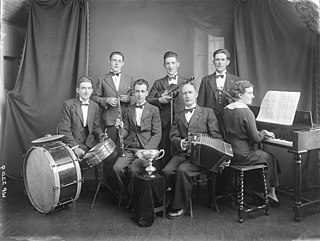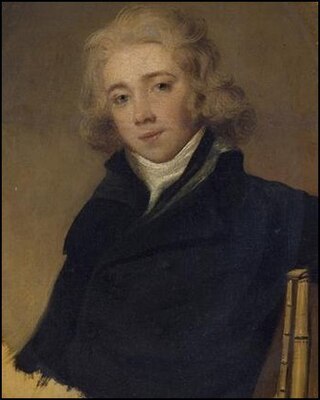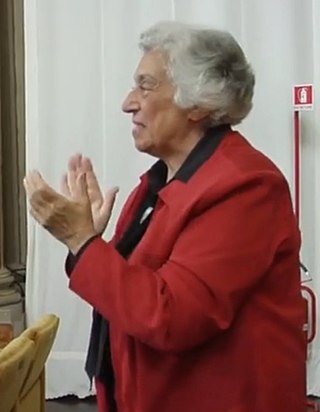
A septet is a formation containing exactly seven members. It is commonly associated with musical groups but can be applied to any situation where seven similar or related objects are considered a single unit, such as a seven-line stanza of poetry.
A piano sextet is a composition for piano and five other musical instruments, or a group of six musicians who perform such works. There is no standard grouping of instruments with that name, and compared to the string quartet or piano quintet literature, relatively few such compositions exist. The best-known piano sextet is probably the Sextet by Poulenc, one of the pinnacles of the wind and piano repertoire. Chausson's Concert is widely regarded as one of the masterpieces of French strings and piano chamber music literature.

The Octet in F major, D. 803 was composed by Franz Schubert in March 1824. It was commissioned by the renowned clarinetist Ferdinand Troyer and came from the same period as two of Schubert's other major chamber works, the 'Rosamunde' and 'Death and the Maiden' string quartets.
The two Serenades, Op. 11 and 16, represent early efforts by Johannes Brahms to write orchestral music. They both date from after the 1856 death of Robert Schumann when Brahms was residing in Detmold and had access to an orchestra.
In music, a nonet is a chamber music composition which requires nine musicians for a performance. The standard nonet scoring is for wind quintet, violin, viola, cello, and double bass, though other combinations are also found. Additionally, the term may apply to a group of nine musicians regardless of whether they are playing chamber music.

Louise-Marie Simon, pen name Claude Arrieu, was a prolific French composer. She wrote hundreds of works in varying formats, including stage works, concert works, and movie scores. She was also a teacher, and worked as a producer and assistant head of sound effects at French Radio.

Louise Farrenc was a French composer, virtuoso pianist and teacher of the Romantic period. Her compositions include three symphonies, a few choral works, numerous chamber pieces and a wide variety of piano music.
The Septet in E-flat major for clarinet, horn, bassoon, violin, viola, cello, and double bass, Op. 20, by Ludwig van Beethoven, was sketched out in 1799, completed, and first performed in 1800 and published in 1802. The score contains the notation: "Der Kaiserin Maria Theresia gewidmet". It was one of Beethoven’s most popular works during his lifetime, much to the composer's dismay. Several years later, Beethoven even wished the score to have been destroyed, saying: "That damn work! I wish it were burned!"

Hyacinthe Jadin was a French composer who came from a musical family. His uncle Georges Jadin was a composer in Versailles and Paris, along with his father Jean Jadin, who had played bassoon for the French Royal Orchestra. He was one of five musical brothers, the best known of whom was Louis-Emmanuel Jadin.
Zdeněk Lukáš was a Czech composer. He authored over 330 works.
Jan Zdeněk Bartoš was a Czech composer.
The Melos Ensemble is a group of musicians who started in 1950 in London to play chamber music in mixed instrumentation of string instruments, wind instruments and others. Benjamin Britten composed the chamber music for his War Requiem for the Melos Ensemble and conducted the group in the first performance in Coventry.

The trumpet repertoire consists of solo literature and orchestral or, more commonly, band parts written for the trumpet. Tracings its origins to 1500 BC, the trumpet is a musical instrument with the highest register in the brass family.

Teresa Procaccini is an Italian composer and music educator.
Ivor McMahon (1924–1972) was an English violinist. He played with notable orchestras including the Philharmonia Orchestra and the English Chamber Orchestra and is best known for playing second violin in the Melos Ensemble.
In music, a duodecet—sometimes duodectet, or duodecimette—is a composition which requires twelve musicians for a performance, or a musical group that consists of twelve people. In jazz, such a group of twelve players is sometimes called a "twelvetet". The corresponding German word is Duodezett. The French equivalent form, douzetuor, is virtually unknown. Unlike some other musical ensembles such as the string quartet, there is no established or standard set of instruments in a duodecet.
Hubert Parry's Nonet in B-flat major for nine wind instruments is a composition for chamber ensemble composed around 1877. Not performed in the composers lifetime, it remained unpublished until 1988 when Edition Compusic published the work under the posthumous opus number 70.
Franz Lachner’s Nonet in F major is a composition for chamber ensemble published in 1875.
The divertimenti in B-flat major, K 186/159b, and E-flat major, K 166/159d, are two companion compositions for pairs of oboes, English horns, clarinets, horns and bassoons by Wolfgang Amadeus Mozart.







